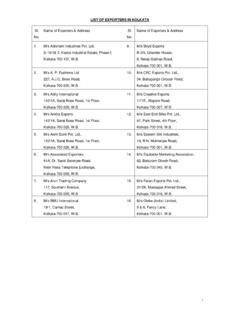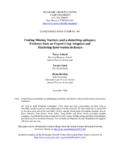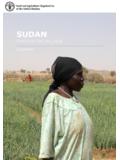Transcription of STRATEGIC APPROACH FOR NEXT THREE YEARS 2017-18 TO …
1 STRATEGIC APPROACH FOR next THREE YEARS 2017-18 TO 2019-20 Future Plan 1. Major intervention would be towards achieving self-sufficiency in import substitute bivoltine silk and bringing shift from cross breeds to improved cross breeds, to make Indian silk industry self-sufficient globally competitive by 2020. For the purpose, continuous development of silkworm breeds by exchange of genetic material through collaborative research, horizontal expansion in non-traditional/ drought and salt affected soils etc., will be the focal points of intervention. Climate resilience sericulture, organic farming, use of non-conventional energy, strengthening public extension system, Swacchha Resham Adarsh Gram, IT enabled effective monitoring system are the focus areas of intervention, Fundamental research will be taken up through scientific Institutes of repute and CSB will focus on adaptive research and front line demonstration of improved technology packages for field application.
2 2. Support to address critical gaps in infrastructure at stakeholder level viz., rearing houses, seed multiplication infrastructure with focus on large scale farming & seed production with private participation, strengthening of Seri-input delivery mechanism and mechanization will be continued to improve the productivity, quality and reduce the drudgery. 3. Attempts to improve the quality of silk yarn to international standards and reduce wastage, Automatic Reeling/ Automatic Dupion Reeling units with focus on indigenously made automatic reeling machines will be undertaken. Support to the post silk yarn sector to strengthen the activities such as Silk Twisting, Weaving, Dyeing & Finishing for creation of State-of the art technology like high end Shuttle-less looms, Arm dyeing, Digital printing machines etc.
3 To meet the export requirements. Post Yarn sector will be support to create better upward marketing channel for quality silk yarn and create better market demand pull and remunerative price for cocoons 4. In order to diversify the utility of silk, production of silk for diversified and non-textile purpose will be attempted with focus on development of blends, knitted and non-woven fabrics & structural finish besides water use reduction/ recycling and energy saving/ use of new & renewable energy in processing industry. 5. Use of Silk in Biomaterial research in the medical field for applications such as sutures, surgical bandages, optical devices, cell scaffolding and adhesive gels and also in cosmetic fields would be taken up. 6. To promote Vanya Silk production, efforts would be made for raising silkworm food plantation under the National Afforestation Programme and other developmental initiatives of other agencies like Ministry of Rural Development, Ministry of Environment, Forests & Climate Change besides encouraging private participation in silkworm seed multiplication.
4 7. To improve the quality and reelability, suitable cooking and conversion machines will be developed in vanya sector to increase the yardage and also production of silk suitable for warp, which is widely imported at present. 8. To improve domestic consumption and exports, necessary interventions in by-product utilization viz., pupa as fish/poultry feed, nutraceuticals, sericin in cosmetics, Product/ design development and diversification, market support/ intelligence studies to keep track of consumer trends will be taken up besides creating price stabilization fund for cocoons and silk. 9. Towards building the capacities of personnel involved in silk industry and the stakeholders, multi-dimensional APPROACH viz., faculty development programme, foundation/Orientation programme, capacity building & training in R&D and seed sector, Skill Training & Enterprise development Programmes, Sericulture Resource Centres will be organized besides Information, Education & Communication.
5 The system of Training impact assessment shall improve the quality of training and increase employment linkage in the sector. 10. In-order to instill quality standards in the entire silk production process emphasis will be given for quality certification of silkworm seed, cocoon, raw silk and finished goods as per quality norms 11. In-order to promote Indian Silk in international market brand boosting activities will be taken up on large scale covering generic promotion of Indian Silk, brand building publicity programmes, exhibition, road shows, documentary, buyers / sellers meeting etc., to boost silk export 12. As per the commitment made by CSB, action will be taken to develop seri-tourism corridors, issue of soil health cards to farmers, harness modern technology for sericulture extension, develop seri-data base portal for farmers and silk portal for single window based information support for sericulture extension etc.
6 IV. FOCUS AREAS FOR THE next THREE YEARS 2017 - 2020: In order to achieve the target of producing 38500 MT of quality raw silk to meet the domestic demand by the end of the year 2019-2020 and to make the import of bivoltine raw silk to zero, the Central Sector Scheme Integrated Scheme for Development of Silk Industry Central Silk Board shall focus on the following thrust areas: A. R&D, Training, TOT and IT initiatives R&D i) Mulberry Sericulture Development of suitable Breeds to increase production and productivity in the harsh climatic conditions that may arise due to global warming and other phenomena like El Nino effect. (Climate resilience sericulture) Collaborative Research with international sericulture research institutes to strengthen genetic base and hybrid vigour Biotechnological and molecular biological tools to expedite development of trait specific silkworms and their host pants.
7 Development and adoption of mechanization in silk production process to reduce dependency on hired labour and drudgery to attract younger generation. Soil, water and nutrient management Focus on harnessing non-conventional energy, integrated farming system to reduce input cost and increase the income of stakeholders Reduce gap in technology adoption and dissemination loss Focus on Transfer of Technology through Cluster Mode APPROACH . (Cluster Promotion Programme and Institute Village Linked Programme) Shifting the production base from industrialized traditional areas to non-traditional areas for horizontal expansion to meet the silk production target Strengthen Capacity Building measures for dissemination of improved technology to the field Promote R & D to increase the crop cycles in North Western and North Eastern Zone to make sericulture more attractive Promote production of import substitute bivoltine silk to the tune of 8500 MTs per annum by 2020 to become self-reliant and bring silk import to zero level ii) Vanya Sector Development of conservation strategies for different eco-races of Tasar and Muga silkworms.
8 Genetic improvement of tasar, eri and muga silkworms through both conventional and modern biological means. Improvement in cooking, reeling and processing techniques and popularization of improved reeling devices to increase productivity and quality of silk Promote Organic Farming and Eco friendly Silk iii) Post Cocoon technology Commercialization of indigenous Automatic Reeling Machines, improved Tasar / Muga Reeling Machine, Wet Reeling Machine and improved Vanya Silk Spinning Machine under Make in India Programme Consolidation of specific ongoing post cocoon research projects based on industry requirement and technical feasibility rather than taking up too many research projects of academic interest. Promote Biomaterial research Silk protein for medical and cosmetic uses Focus on bye Product utilization (Pupa, Sericin, Silk waste etc.
9 ,) Upgrade reeling technology to produce import substitute silk Promote Product Design, Development and Diversification to boost the Silk Export Brand Promotion Generic Promotion of Indian Silk. Promotion of Silk Weaving & Processing Training Focus on capacity building and training to generate skilled manpower Faculty development programme, foundation/Orientation programme, capacity building & training in R&D and seed sector, Skill Training & Enterprise development Programmes, Sericulture Resource Centres will be organized. The system of Training impact assessment shall improve the quality of training and increase employment linkage in the sector. Information, Education and Communication (IEC) for effective transfer of technology IT Initiatives Promote M-Kissan portal for Sericulture Advisory Services to farmers Promote SMS Service for Cocoon and Silk rates to the farmers and reelers Computerization of CSB units for Data Warehousing and dissemination through portals Application of Remote Sensing and GIS for analysis and selection of unutilized potential areas for promoting sericulture through SILKS Portal National Seri Data base of all sericulture stakeholders for collecting & dissemination of Database of monitoring the raw silk production in the country Promote regular Video Conferencing with Stakeholders and Implementing Agencies to monitor the progress of implementation through NIC network to save time and cost.
10 Generation of awareness on technology improvement / adoption of technology through Print and Electronic medial like air and satellite programmes Promote Voice Based Mobile Advisory service to reach the un educated stakeholders Voice based information flow to registered stake holders Publicity of sericulture plan programmes, achievements and sharing of success stories Implementation of Digital India programme B Seed Organizations Focus on elite, nucleus and basic seed production of improved Bivoltine breeds and Vanya silkworm seed. Oversee and ensure maintenance of four tier silkworm seed production network, (Elite, Nucleus, Basic and Commercial seed). Upgrade Seed Multiplication facilities to match the raw silk production targets Promote Private Entrepreneurs for Industrial Seed Production and installation of Cold Storage units for commercial use under Mulberry sector to meet the Bivoltine Seed requirement.


